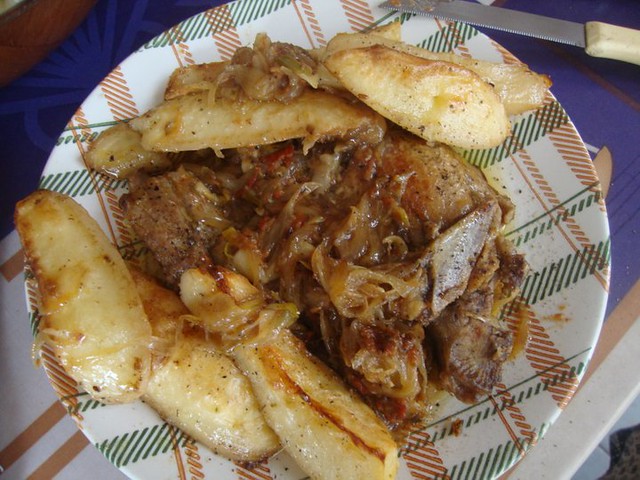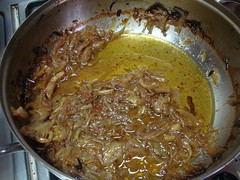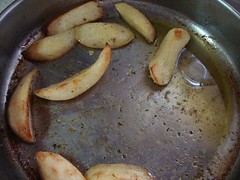"A colleague recently asked another food writer where a recipe she featured came from, and the reply was 'from the internet'." Claudia Roden, A Taste of Thyme, 2000.
When Saturday's weather took a turn for the worse last Sunday, I had to make new plans for the pork chops that I had defrosted. I couldn't barbecue them outdoors, as we had planned, so I decided to use the internet to give me some ideas about how to cook them. The rise in 'internet cuisine' is helping to teach people how to cook, as well as creating global food trends; cooking has never been so easy or as interesting as it is now. Using 'pork chops' as a search string, I was mesmerised by the number of images that came up showing well-cooked pork chops, sizzling brown on the outside, sitting on a range of dressings, their juices oozing out onto the plate. So much value for money from a simple broadband internet connection - I could not get this much value from a book. In an environmentally more conscious world, it's a luxury to hoard paper; apart from online sources, we can now use electronic readers. I don't want to believe that the age of the paper book is over, but it certainly looks to be going that way.
In Greece, pork is a very popular meat. It's the main one used to make the nationally popular street-food souvlaki, both in a pita bread and on a skewer. Grilled pork chops are a standard feature at tavernas, cooked over charcoal, and similarly for home barbecues. The Greek seasonings for pork chops usually consist of oregano, ground pepper and salt, with lemon juice sprinkled over them. Sometimes, pork chops are marinated in wine before grilling. That's the general Greek way of cooking pork steaks. In the winter when the weather makes it difficult to cook outdoors, they are usually placed under a grill in a conventional oven.
A little while ago, we managed to get hold of some locally reared pork. My husband was called up by a friend: "A pig will be slaughtered tomorrow," he informed him, "it's first in, first served." So he went out to the village of Nippos, where a farming family runs a dairy station, raising mainly sheep and goats, producing various milk products, curing olives and keeping a few pigs for the eventual sale of their meat. My husband bought back enough for 5 family-sized meals. We paid 5.50 euro per kilo, which is similar to the retail price of pork (it can go down to 3.50 euro per kilo when sold on special). When he bought it home, we left it in the fridge for three days to allow the remaining blood to drain away, then placed it in the freezer. This is the first time that we have bought pork with such transparency; we do this more often with sheep or goat meat.
As I pondered about how I would cook our first meal using that meat, I decided to look up a few photos of pork chops on the internet. I showed them to my husband: he was mesmerised by the tempting food porn showing pork steaks in a range of poses, dressed in a variety of sauces and seasonings. He particularly liked the look of this set of photos, but was rather taken aback by the ingredients list: apple juice, brown sugar, soy sauce and mustard! I know what he was wondering: how can a dish containing such unusual ingredients (for Greek standards) look so good?
 In
In Although we may be veering towards a world that functions according to global trends, we're still a world full of different people, with our own culinary idiosyncratic preferences and dislikes. There is still a sense of national standards in the food people eat around the world. Greece is one of those countries where food is still perceived according to a set of national standards rather than global ones. Home-cooked family meals are still associated with known favorites. I often use the internet for cooking ideas, but I still need to make sure that the meal will suit the tastebuds of my eaters, as well as the availability of ingredients in my kitchen on a Sunday morning (apple juice is still considered to be quite definitely 'foreign' in Crete). What interested me more was the technique used in the original recipe to cook the meat, which was well illustrated and described by the author. My adapted recipe using common ingredients in a Cretan kitchen resulted in a very tasty and satisfying meal for all of us.
You need:
4 pork chops (don't trim the fat off)
5 large onions, thinly sliced
1 tablespoon of prepared mustard (mustard is just as common as mayonnaise all over Greece)
3 large tablespoons of home-made tomato sauce (a teaspoon of tomato paste diluted in a wineglass of water can replace this)
1/2 wine glass of Cretan home-brewed wine
a glass of water
3-4 drops of tabasco sauce (optional: for such a large meal, you'd expect more drops to experience heat; I am simply introducing it in small doses)
olive oil (it's difficult for a Cretan to quantify the amount of olive oil used in an individual recipe: my measurement is usually in 'glugs')
oregano, salt and pepper
Our Sunday meals are the ones that usually involve more thought than the meals I cook during the week - but they are also the ones that I would say are easier to prepare.
Set the oven to heat up at 180C. Heat some olive oil in a Dutch oven on the stovetop and sautee the onions till soft and translucent. While they are cooking, place the mustard, tomato sauce, water, wine and tabasco sauce in a bowl and blend the ingredients well. When the onions are ready, set them aside, and heat up some oil in another saucepan, enough to cover its surface like a thin film. The saucepan should be large enough to hold the pork chops. Place them on the pan, seasoning them with salt, pepper and oregano. Let them cook on high heat till they are brown on both sides (about 5 minutes), turning them once and seasoning them again. Then pour the liquids over the pork chops and let them cook in this sauce for about 5 minutes. Now lift the pork chops out of the pan and place them over the onions, then pour the sauce over them. Seal them with the lid of the Dutch oven and place them in the oven to cook till tender; this will take about 30 minutes.
Either I was too tired to remember to photograph the different stages of the meal, or it was too good to wait. What you see here is the remains of the meal, which were combined and re-heated the next day as leftovers.
To add some bulk to the meal, I cooked (separately) some lemon potatoes, which should be placed in the oven half an hour before the pork chops, so that everything will cook at the same time and can be served together. All you need is a salad and some good wine to complete the meal.
©All Rights Reserved/Organically cooked. No part of this blog may be reproduced and/or copied by any means without prior consent from Maria Verivaki.



Served with some lemon potatoes I would have to say this a meal I could not pass up Maria.
ReplyDeleteFunnily enough I just did pork cutlets too. And with mustard. Love the whole dish Maria. Thanks!
ReplyDelete